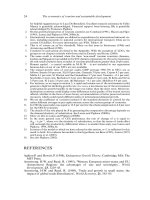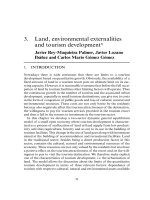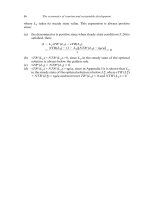THE ECONOMICS OF MONEY,BANKING, AND FINANCIAL MARKETS 179
Bạn đang xem bản rút gọn của tài liệu. Xem và tải ngay bản đầy đủ của tài liệu tại đây (39.19 KB, 1 trang )
CHAPTER 7
A PP LI CATI O N
Stocks, Rational Expectations, and the Efficient Market Hypothesis
147
The Subprime Financial Crisis and the Stock Market
The subprime financial crisis in the United States that started in August 2007 led to
one of the worst bear markets in the last 50 years. Analysis of stock price valuation, again using the Gordon growth model, can help us understand how this
event affected stock prices.
The subprime financial crisis had a major negative impact on the economy,
leading to a downward revision of the growth prospects for companies, thus lowering the dividend growth rate ( g) in the Gordon model. The resulting increase in
the denominator in Equation 5 would lead to a decline in P0 and hence a decline
in stock prices.
Increased uncertainty for the economy and the widening credit spreads resulting from the subprime crisis also raised the required return on investment in
equity. A higher ke also led to an increase in the denominator in Equation 5, a
decline in P0, and a general fall in stock prices.
In the early stages of the financial crisis, the decline in growth prospects and
credit spreads were moderate and so, as the Gordon model predicts, the stock
market decline was also moderate. However, when the crisis entered a particularly
virulent stage in October of 2008, credit spreads shot through the roof, the economy tanked, and as the Gordon model predicts, the stock market crashed, falling
by over 40% from its peak value a year earlier.
THE TH EO RY O F RATI O NA L EX PE CTATI O NS
The analysis of stock price evaluation we have outlined in the previous section
depends on people s expectations especially of cash flows. Indeed, it is difficult
to think of any sector in the economy in which expectations are not crucial; this
is why it is important to examine how expectations are formed. We do so by
outlining the theory of rational expectations, currently the most widely used theory
to describe the formation of business and consumer expectations.
In the 1950s and 1960s, economists regularly viewed expectations as formed
from past experience only. Expectations of inflation, for example, were typically
viewed as being an average of past inflation rates. This view of expectation formation, called adaptive expectations, suggests that changes in expectations will
occur slowly over time as past data change (see the FYI box, Adaptive
Expectations). So if inflation had formerly been steady at a 5% rate, expectations
of future inflation would be 5% too. If inflation rose to a steady rate of 10%, expectations of future inflation would rise toward 10%, but slowly: In the first year,
expected inflation might rise only to 6%; in the second year, to 7%; and so on.
Adaptive expectations have been faulted on the grounds that people use more
information than just past data on a single variable to form their expectations of
that variable. Their expectations of inflation will almost surely be affected by their
predictions of future monetary policy as well as by current and past monetary policy. In addition, people often change their expectations quickly in the light of new
information. To meet these objections to adaptive expectations, John Muth developed an alternative theory of expectations, called rational expectations, which









